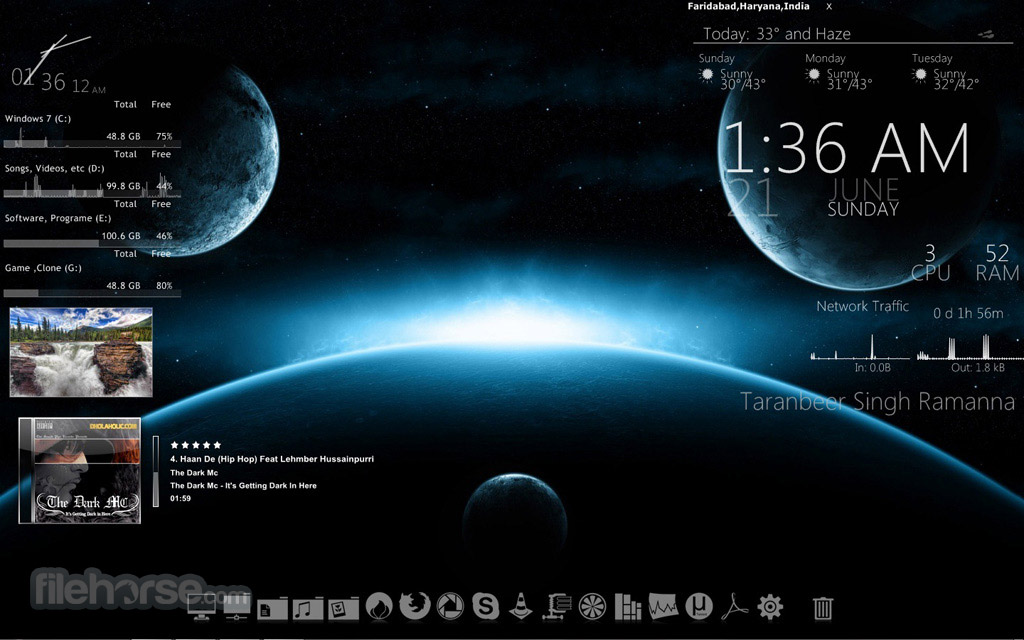
Take care to name each meter, give it a name that relates to what its doing - it will make it easier when you come back to edit things later.
#Rainmeter hardware monitor skin
You'll see what I mean.įor this simple skin there's three parts for each sensor - 1, Read the value. The String Meter is the basic meter to display any text (and value), just change its X,Y position, font size, color, alignment, ect, and the Text=*Your Text*, and give it a different name. The Image Meter can be any image (png, jpg, ect), just put the image in the skins folder and replace SolidColor= with ImageName=*Name of Image*, you can specify a different W,H to the original and Rainmeter will scale it. " to break up different sections and make the skin easier to read. This is the basic format for a Rainmter skin, each meter has a name in square brackets, a type and some arguments and is seperated by a line or two. StringStyle=Normal - Text Style (Normal, Bold, Italic)įontFace=Trebuchet MS - Any font you have installedĪntiAlias=1 - Smooths the font StringEffect=Shadow - Text Effect (None, Shadow, Border) Y=10 - Vertical PositionįontColor=255,255,255,255 - Text Colour (R,G,B,Transparent)įontSize=18 - Text Size

StringAlign=Center - Text Alignment (Left, Right, Center) Meter=String - Meter Type (String for text) Y=0 - Vertical position from top left of skin (in pixels) X=0 - Horizontal Position from top left of skin (in pixels) Meter=Image - Meter Type (image for background) Update=1000 - Updates every second (1000ms) Navigate to the Rainmeter Skins folder (Documents\Rainmeter\Skins), create a new folder in there (call it OHM).
#Rainmeter hardware monitor .dll
dll in Program Files (x86)\Rainmeter\Plugins depending which version your running.Īt its simplest there's measures and meters, measures measure things and meters display what's measured. dll goes in "Program Files\Rainmeter\Plugins", the 32Bit. I did this for my 2 480's.Įdit: It seems filesonic link is unavailable, I found the plugin Here attached to the last post. *If you have two or more of the same hardware you'll need to rename them for Rainmeter to read each, just right click on the hardware name > Rename and add a 1,2 or 3, ect.

You need a program to read the sensors, Open Hardware Monitor seems the easiest to work with so I'm using that, grab it and open it - any of the values shown are available to Rainmeter. Check the guides on to see what else you can do. This is a simple skin to read and display a sensor/clock speed, ect, easy to customize though once you've got the basics. Rainmeter has the ability to read and display pretty much any sensor\load\clockspeed\voltage on any system but no one makes configs to display them all or select a few because every system has different hardware\sensors so they aren't really transferable, you have to make your own - here's how. If you click on the instructions link, it will open up the Gnometer maual-which is oddly enough implemented on a web page and requires Flash.First see Toransu's excellent guide to Rainmeter stickied in the Art/Graphics section: In this example, we want to customize the Weather gadget to show the weather for our location. Under the Skin Settings, you can configure extra settings for some of the available widgets-for instance, if you want to put in your Gmail or Google Calendar details, or configure Facebook, this is where you’d need to go. From here you can customize the placement of the bar and whether it should appear as a bar, floating panel, or transparent.

Once you’ve installed and launched Rainmeter, you’ll immediately notice the bar at the top of the screen, and a couple of default widgets including the Settings dialog. Running through the setup is as simple as clicking through a couple of screens, deciding whether or not you want Rainmeter to start with Windows, and which them you want as the default theme-Gnometer is now the default choice, and that’s what we’ll talk about today.


 0 kommentar(er)
0 kommentar(er)
